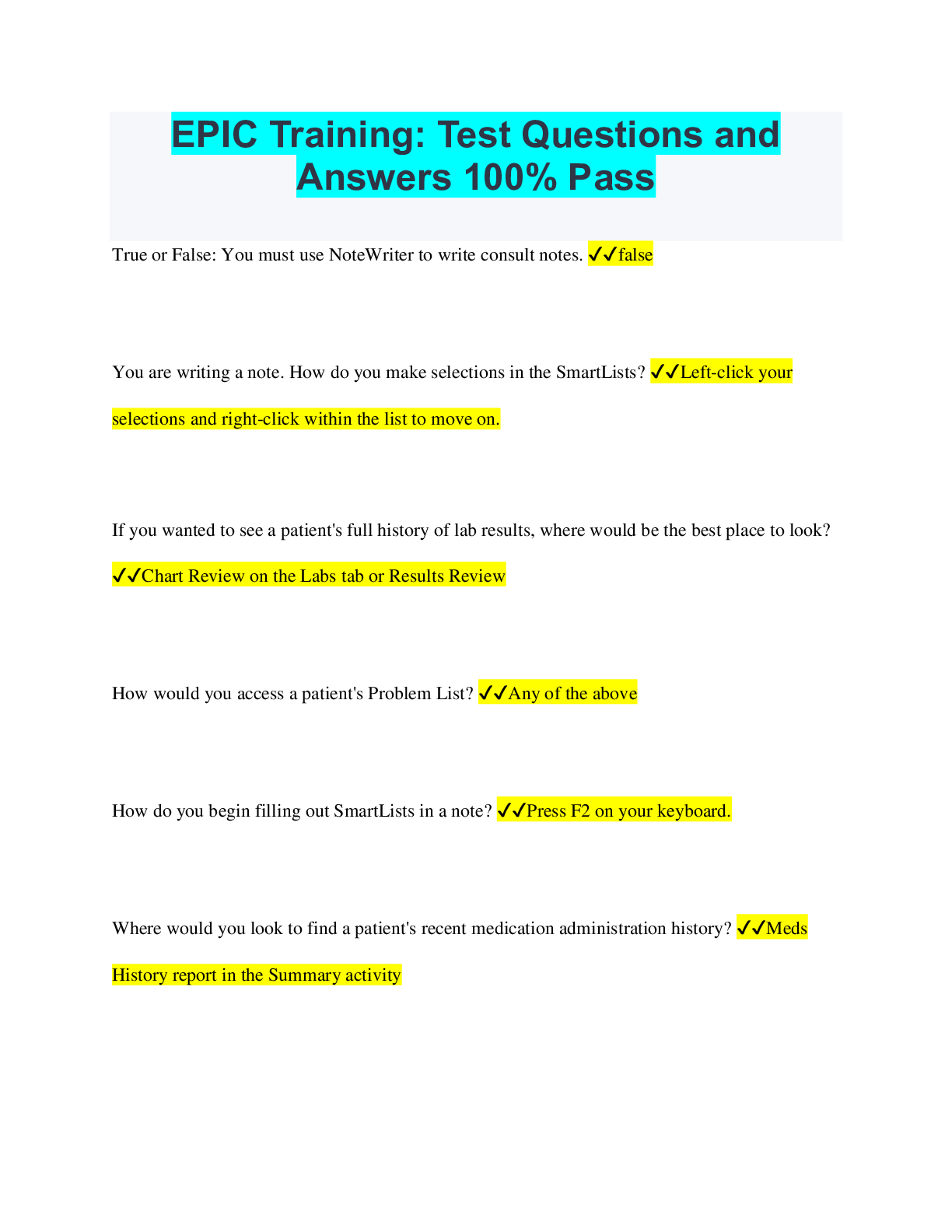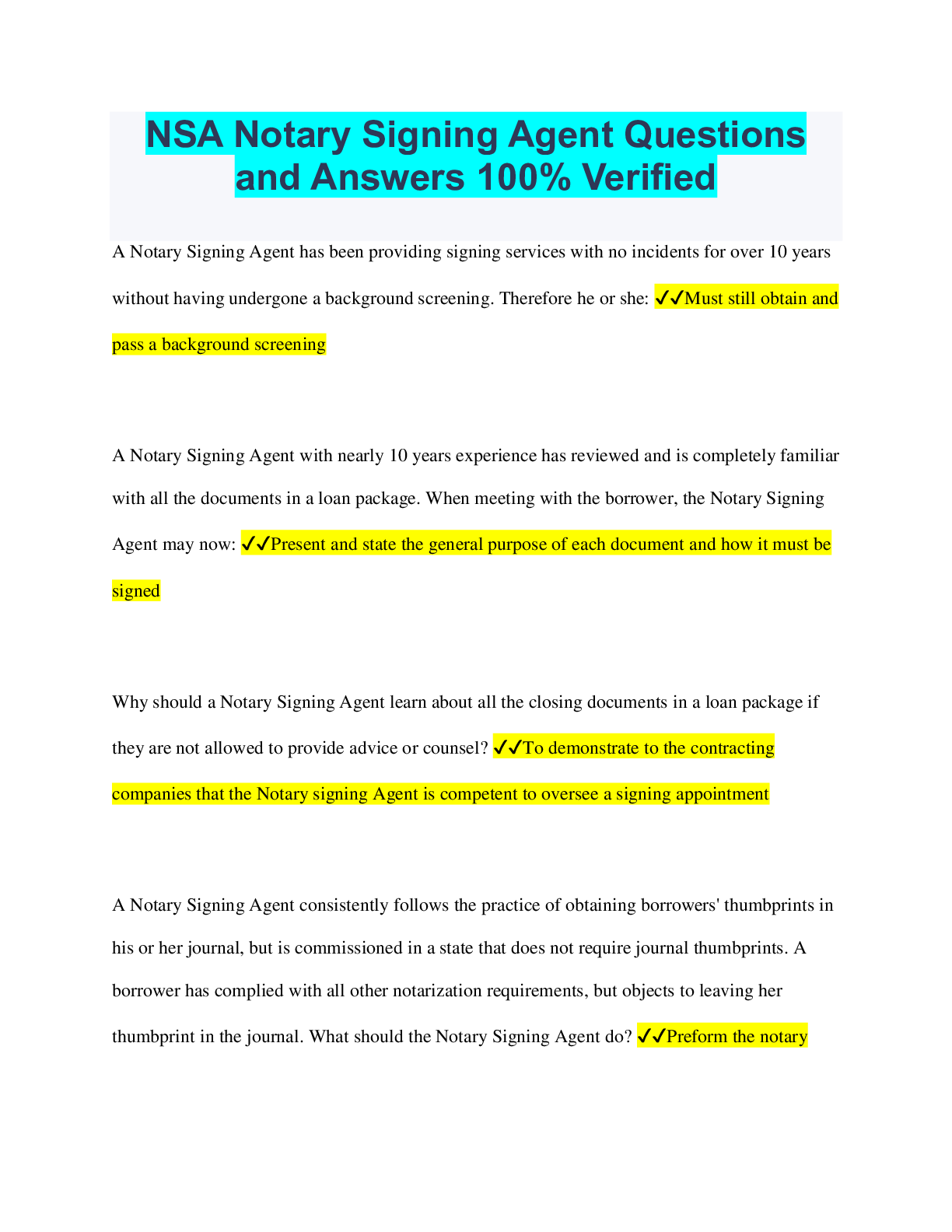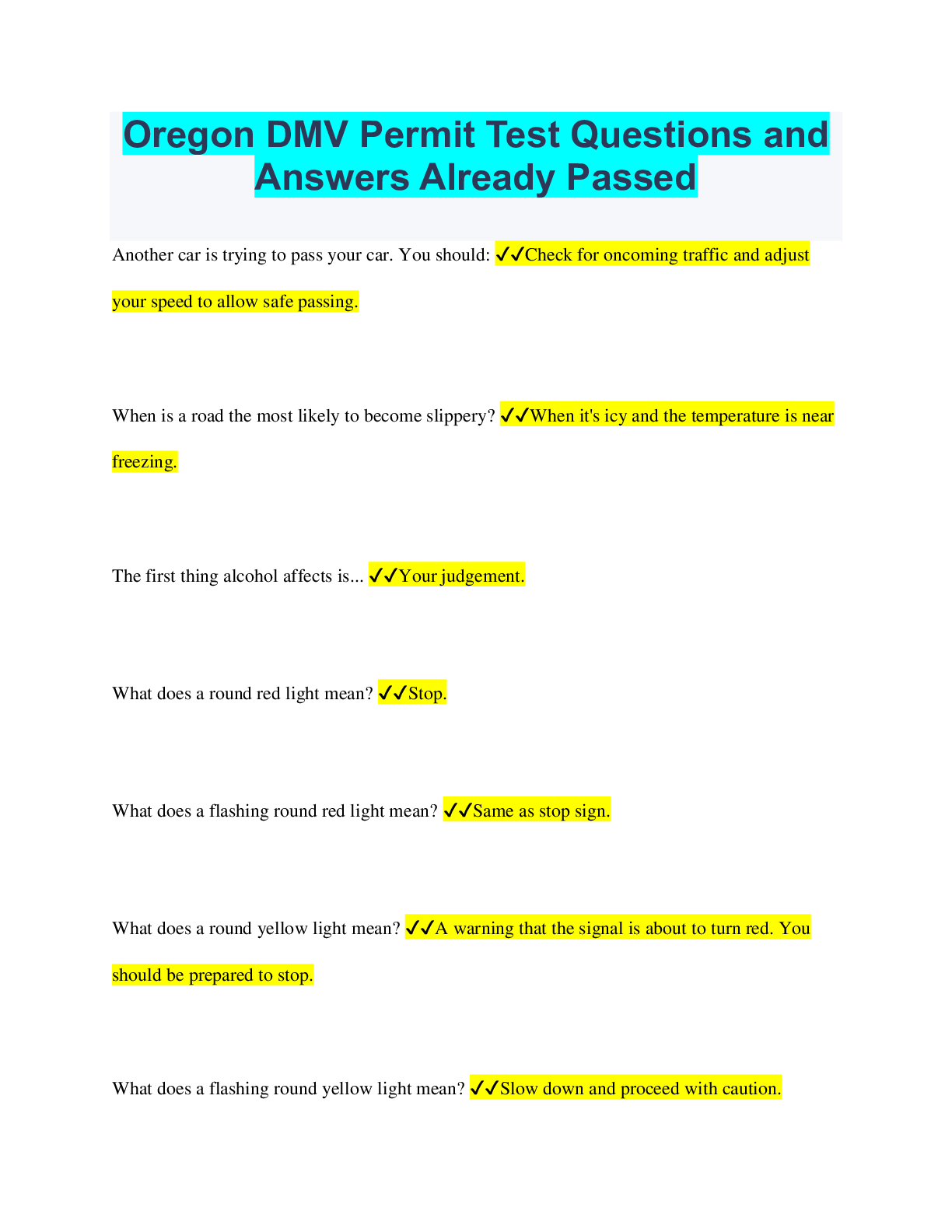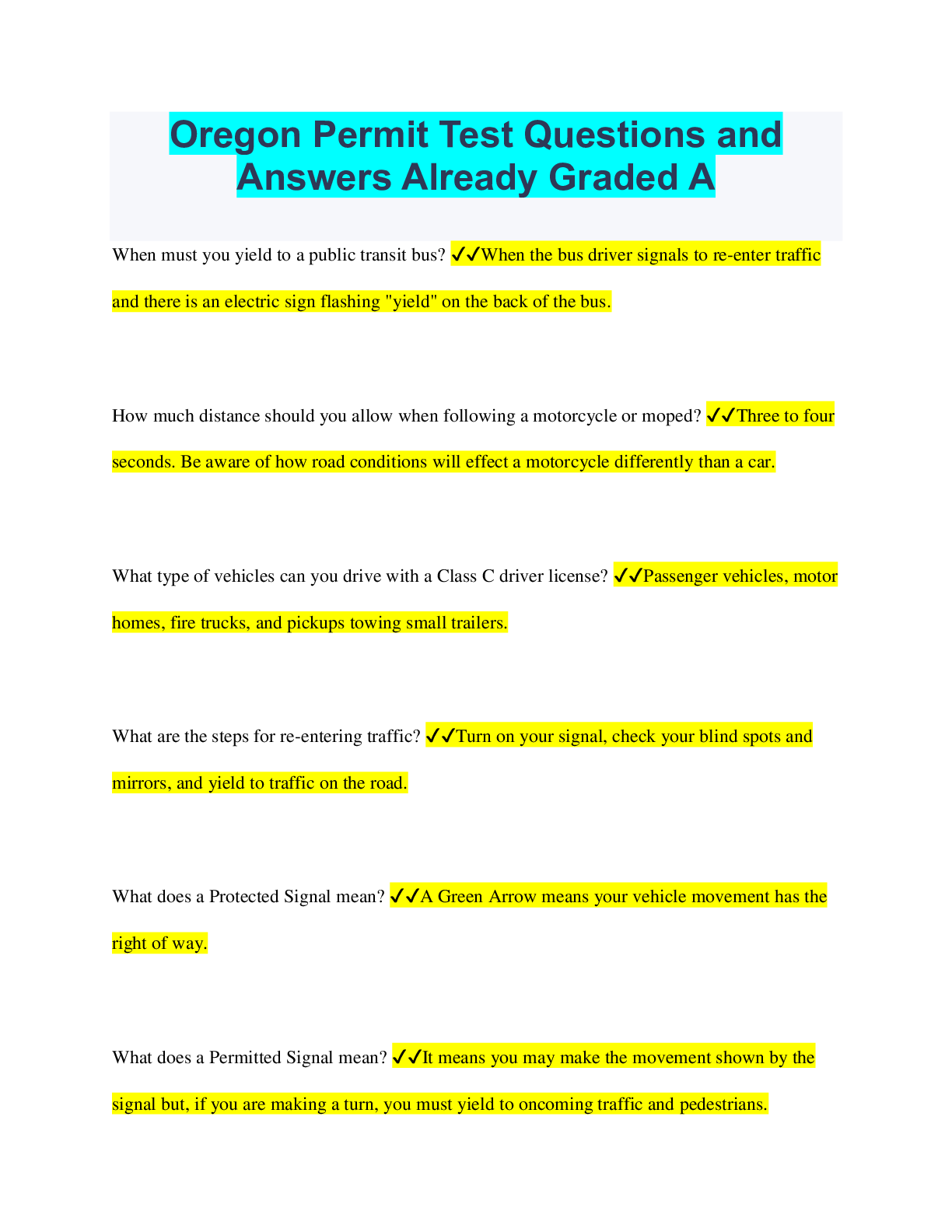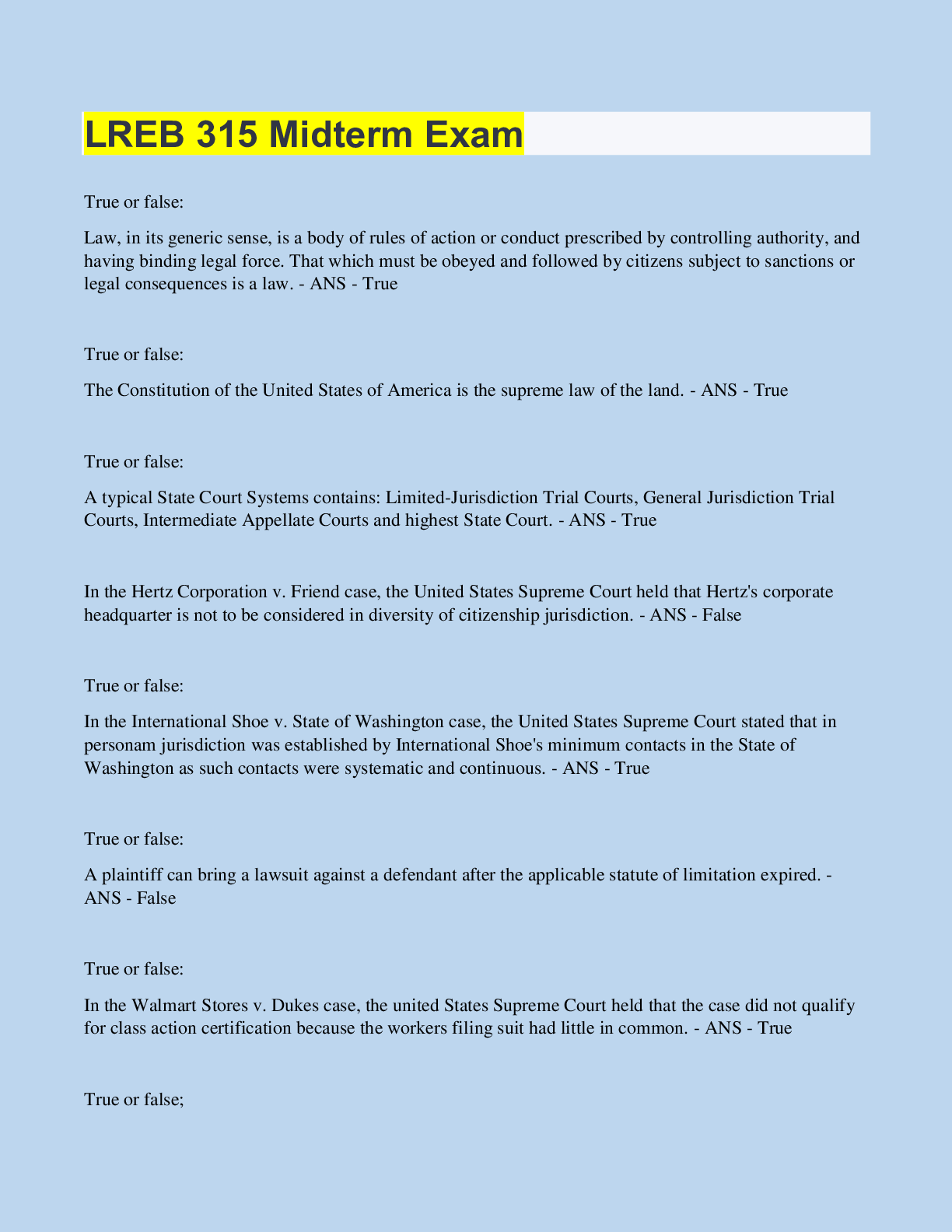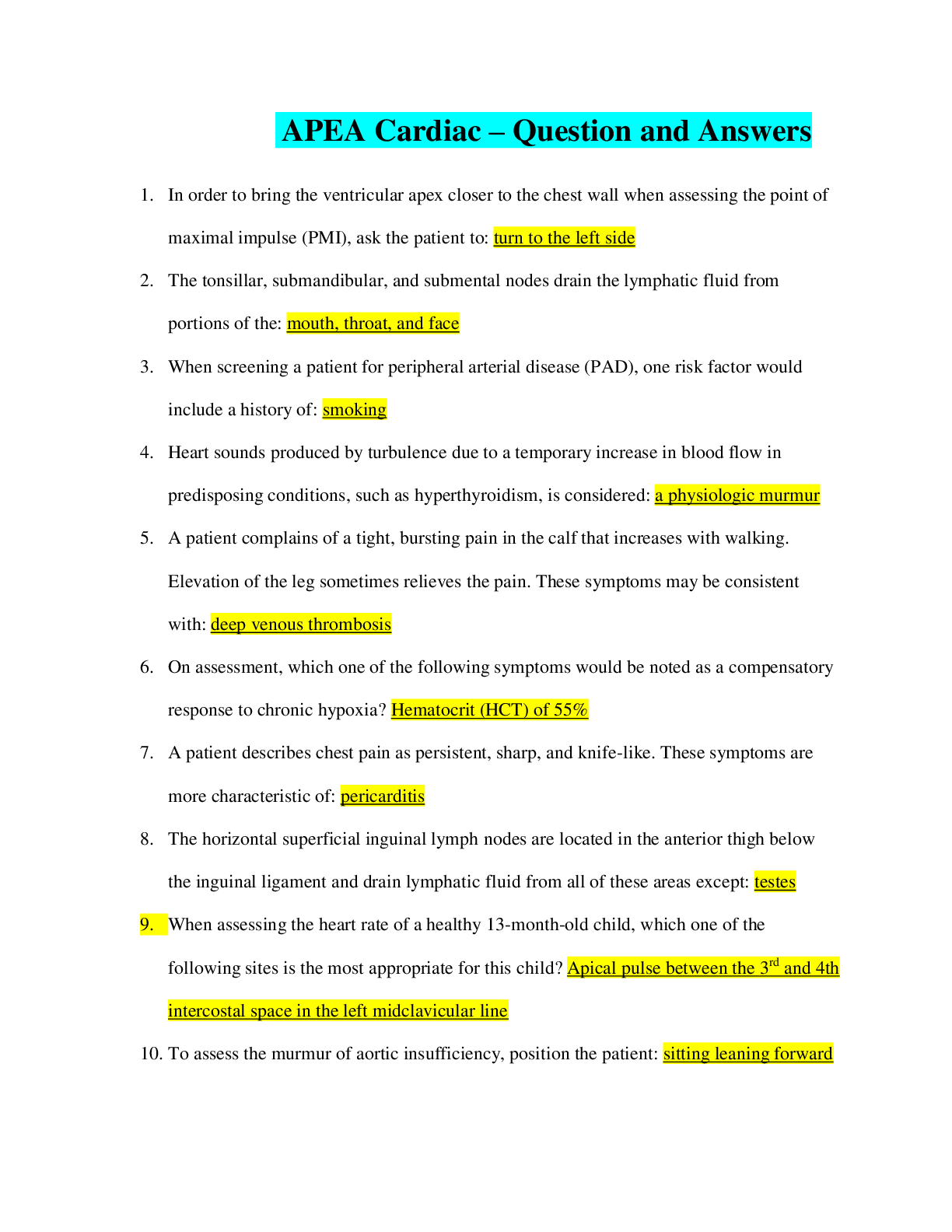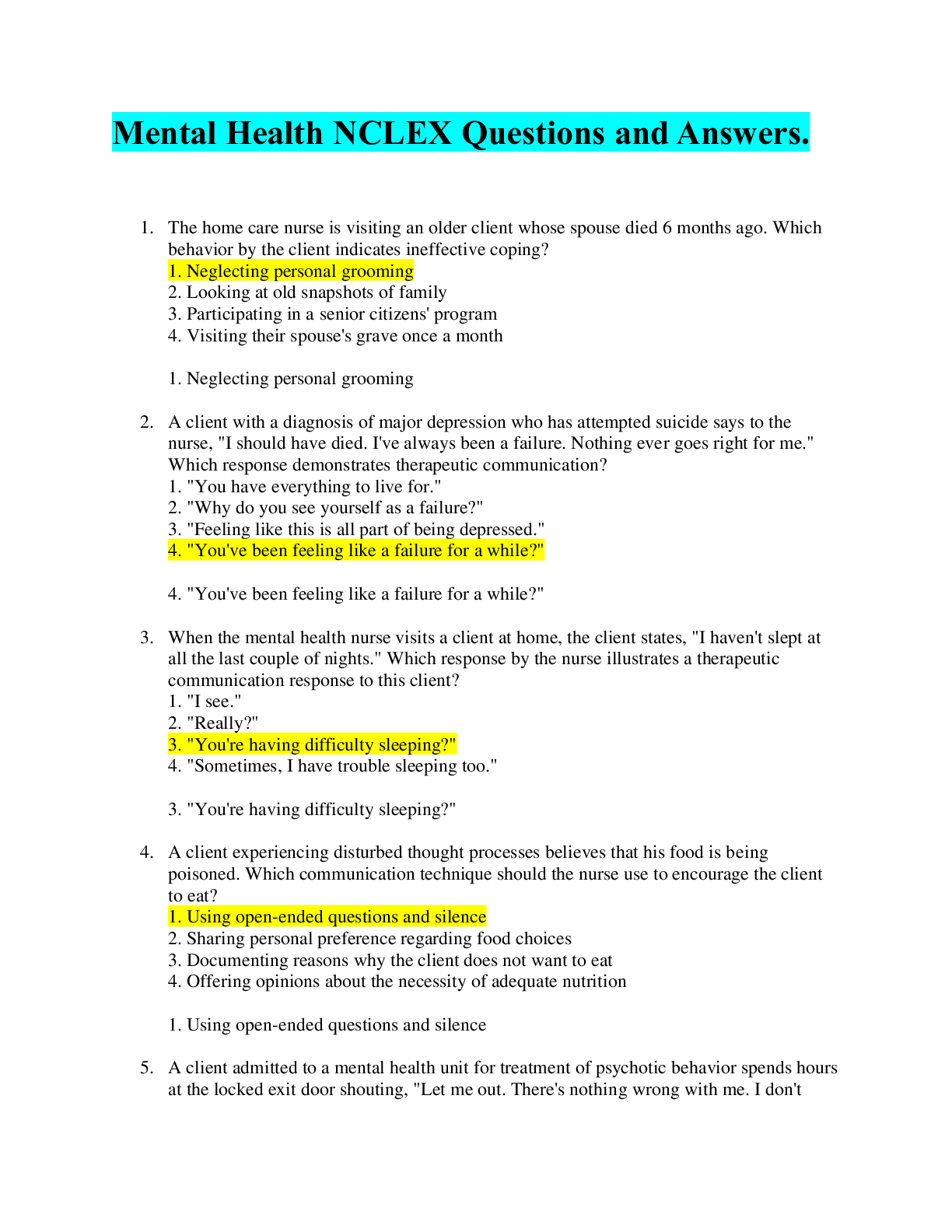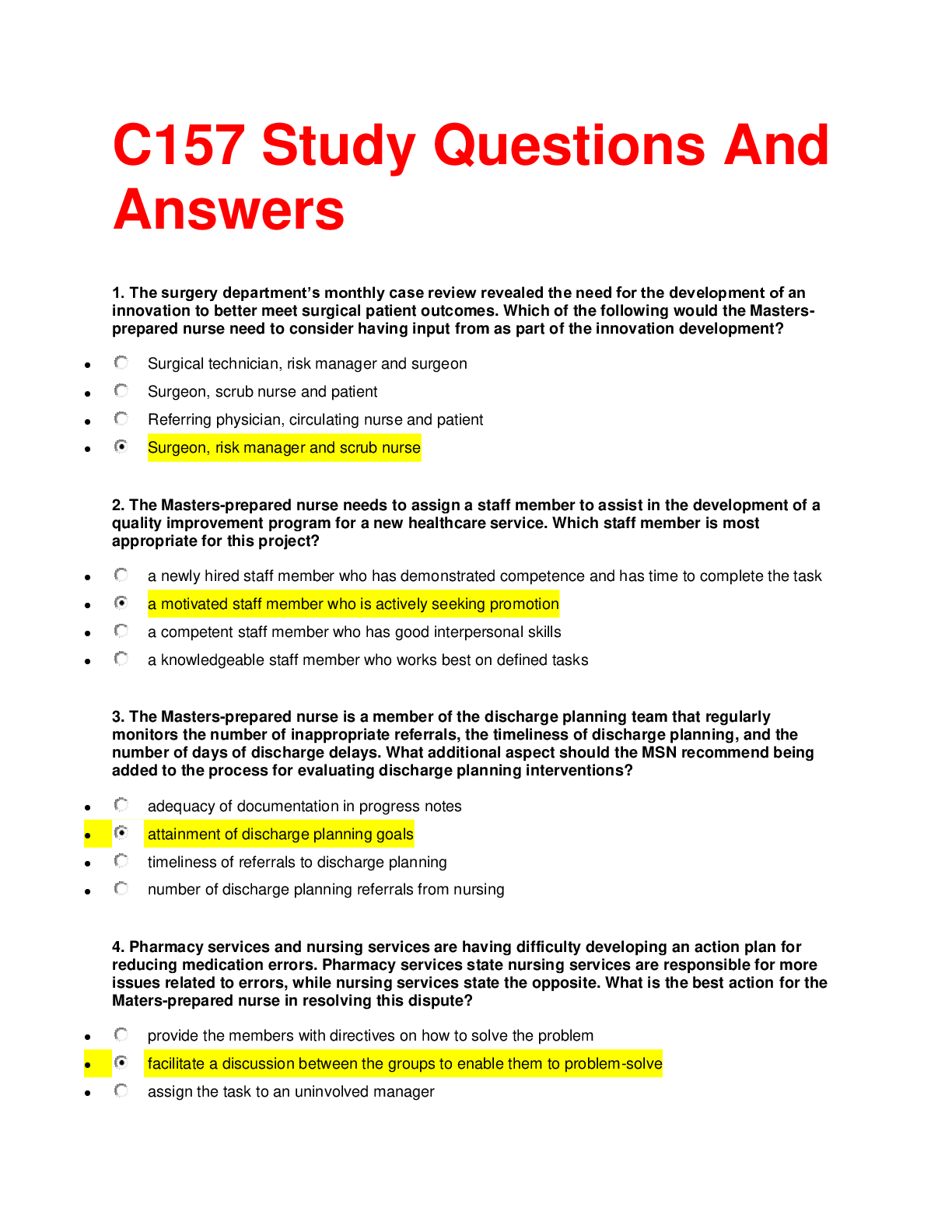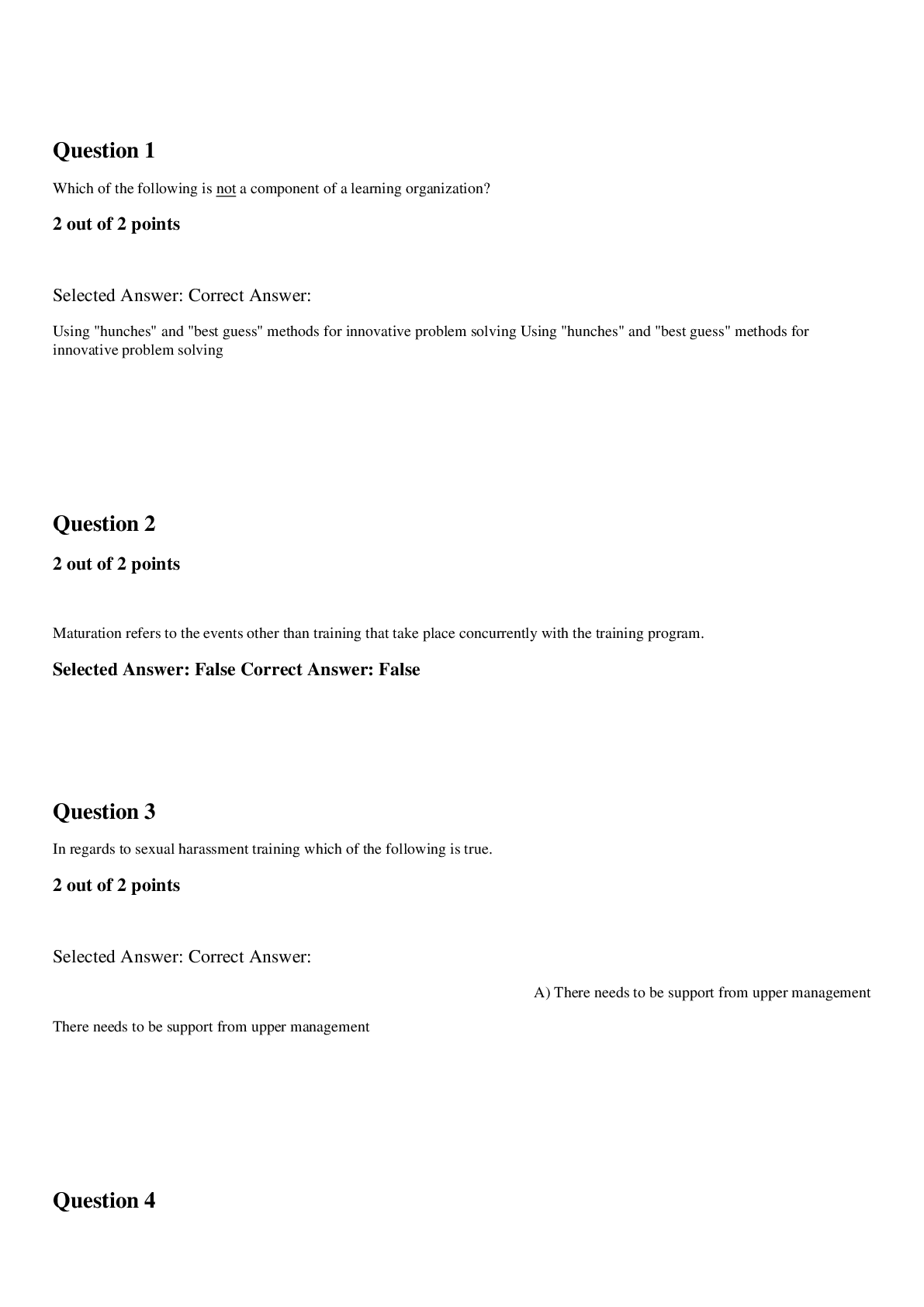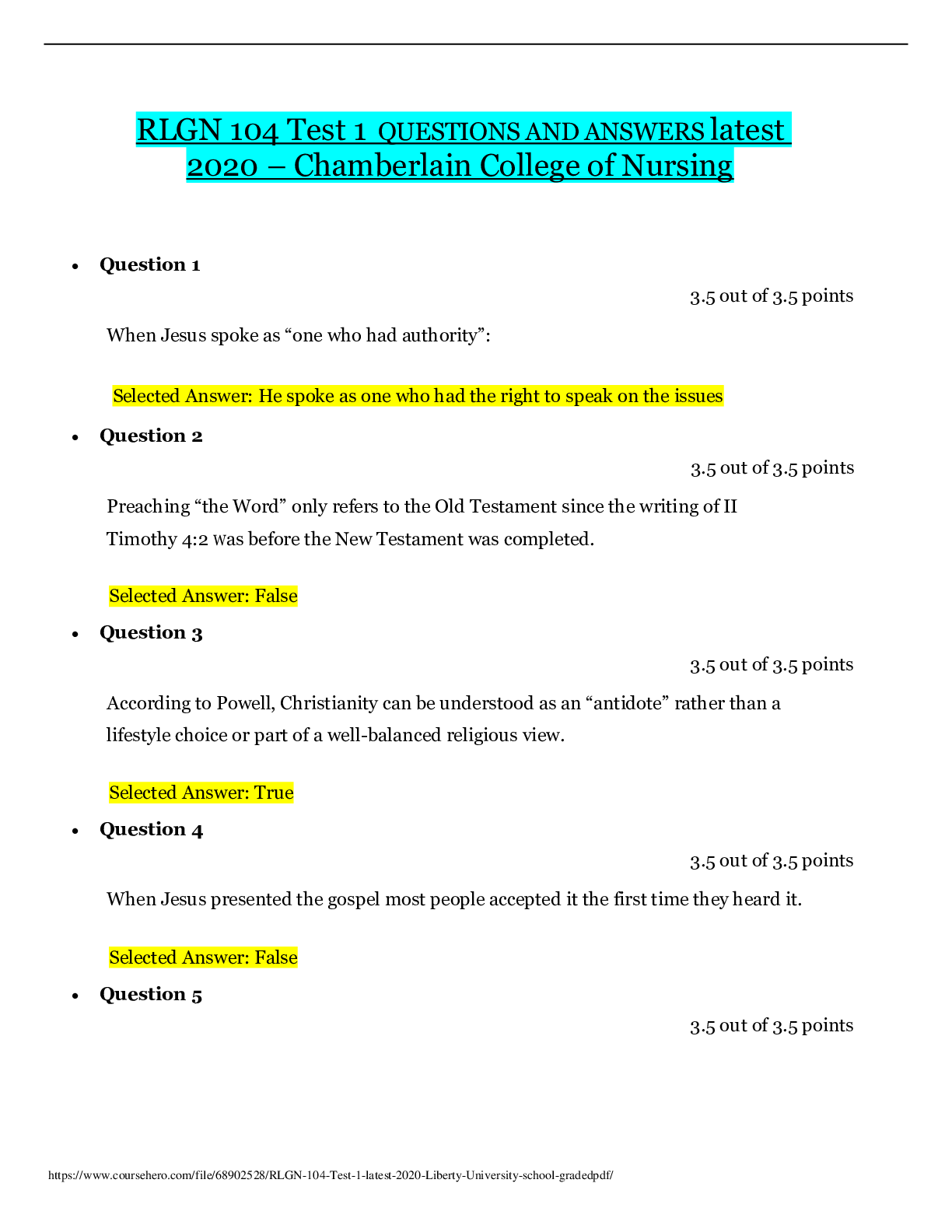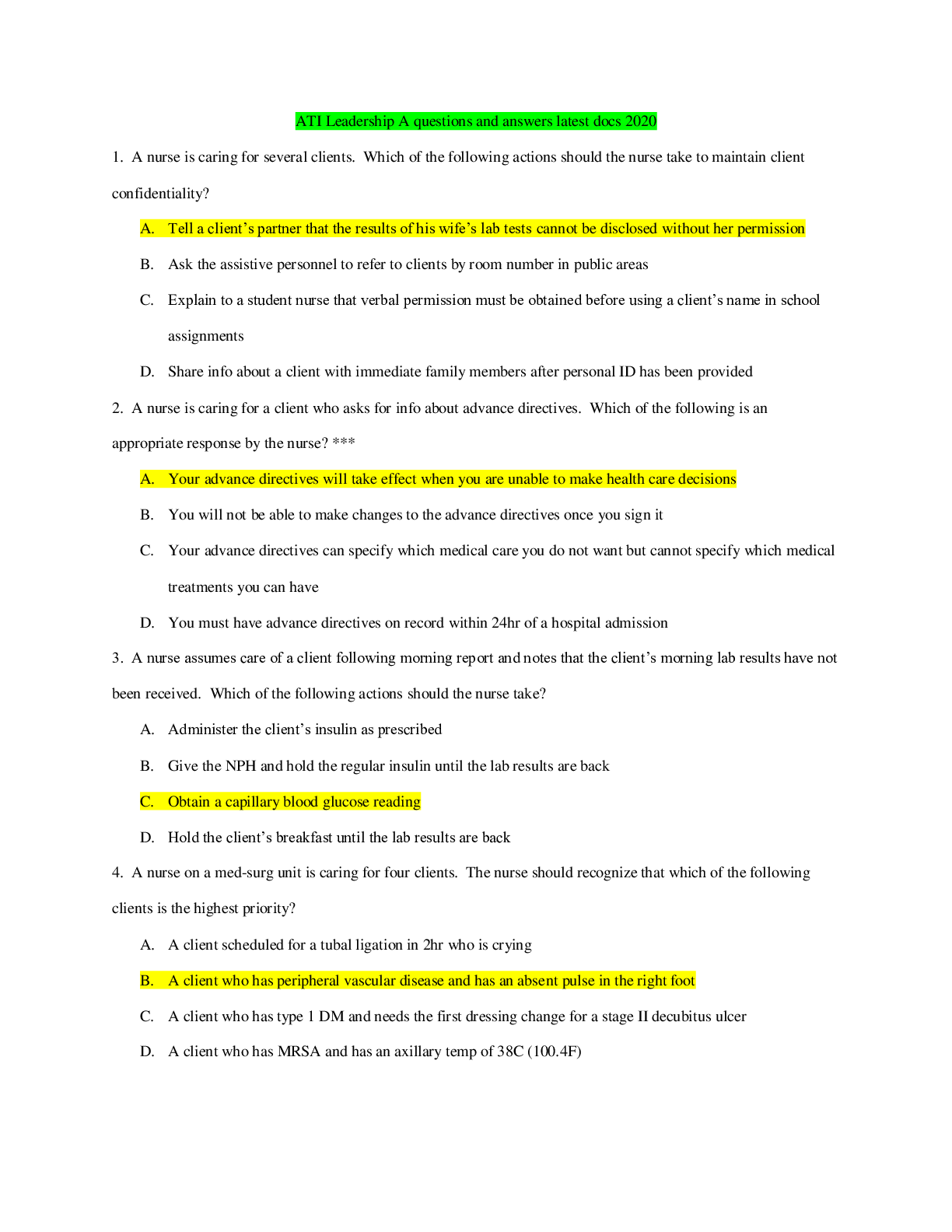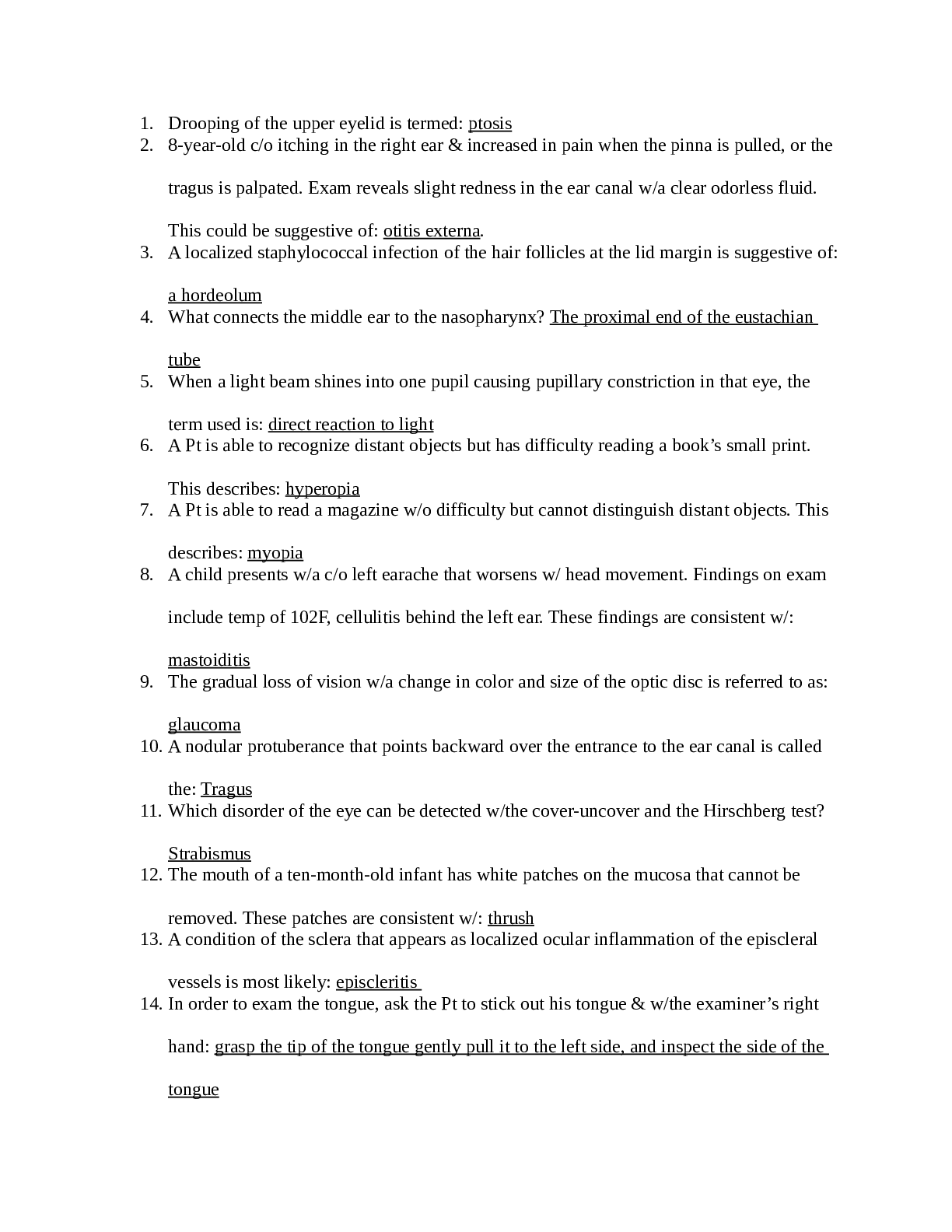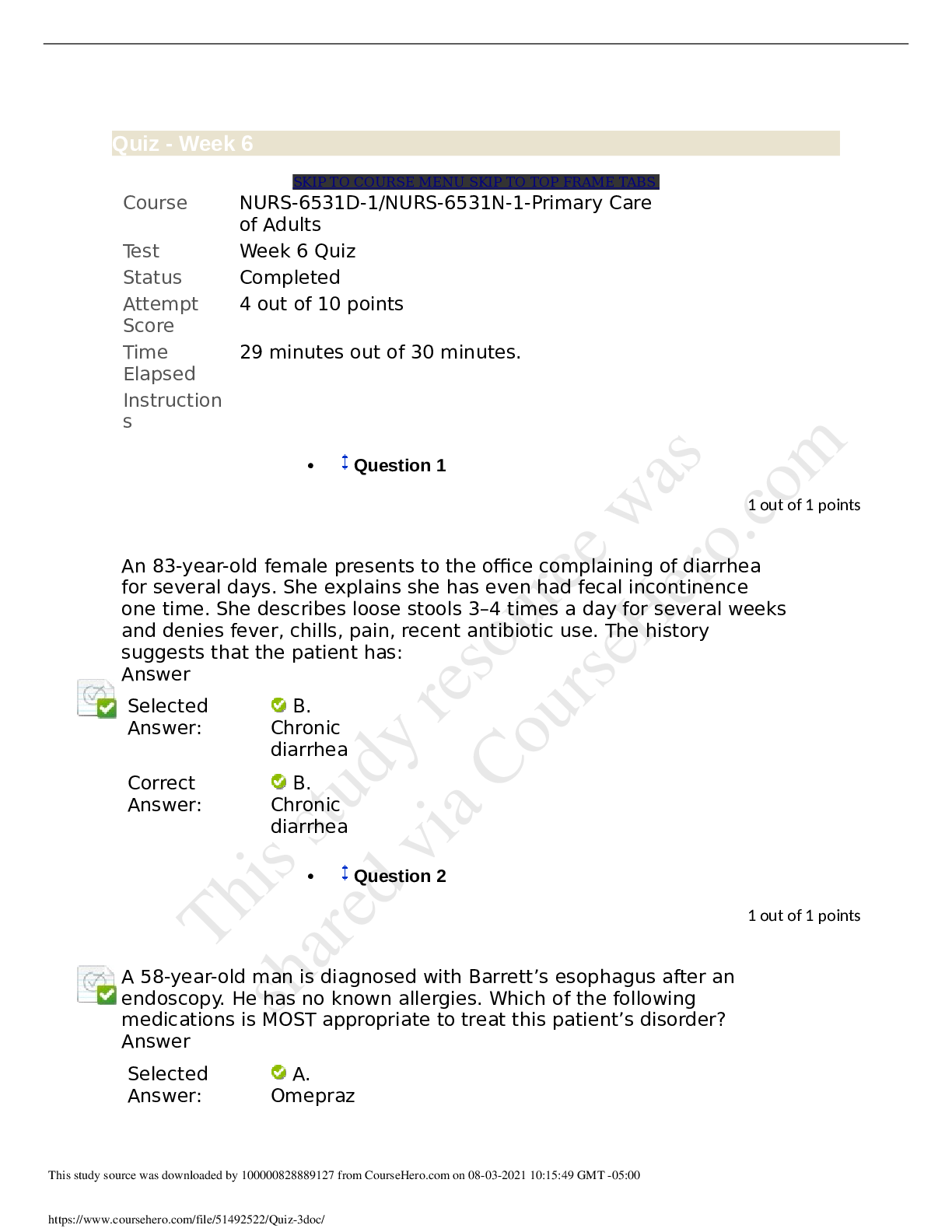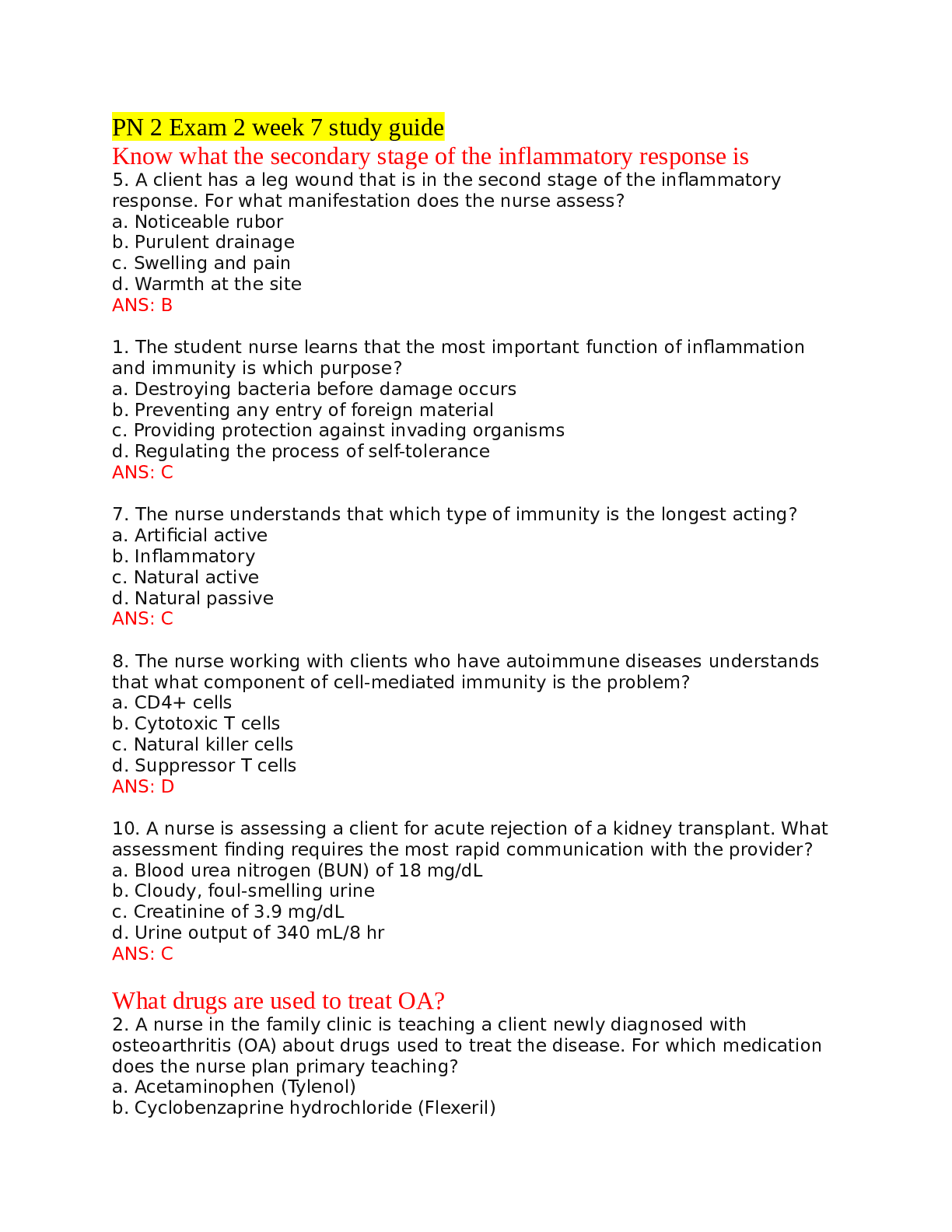*NURSING > QUESTIONS & ANSWERS > Electronic Fetal Monitoring Practice Questions and Answers Latest Updated 2022 Graded A+ (All)
Electronic Fetal Monitoring Practice Questions and Answers Latest Updated 2022 Graded A+
Document Content and Description Below
Electronic Fetal Monitoring Practice Questions and Answers Latest Updated 2022 Graded A+ A nurse is explaining to a pregnant patient the purpose of electronic fetal monitoring. Which of the follow... ing statements by the nurse is the most accurate way to describe the purpose of EFM? a. "EFM is a diagnostic procedure that monitors your baby's heart rate or FHR and your uterine contractions. b. "EFM is a screening procedure that monitors your baby's heart rate or FHR and your uterine contractions." c."EFM is a screening procedure that only monitors your baby's heart rate or FHR." d. "EFM is a diagnostic procedure that only monitors the frequency, duration, and intensity of your uterine contractions." ✔✔b. "EFM is a screening procedure that monitors your baby's heart rate or FHR and your uterine contractions." The nurse measures fetal well being during labor by paying attention to: a. the response of the FHR to uterine contractions b. mom's complaint of pain during the labor c. the FHR only d. the frequency, duration, and intensity of the mother's uterine contractions only ✔✔a. the response of the FHR to uterine contractions A nursing student explains during her presentation that the 5 factors for adequate fetal oxygenation include: 1. normal maternal __________ _________and volume to the placenta 2. normal ___________ ___________in the maternal blood 3. adequate exchange of ___________ and CO2 in the placenta 4. an open ___________path between the placenta and the fetus through vessels in the umbillical cord 5. normal fetal circulatory and ____________ -carry functions ✔✔1. normal maternal blood flow and volume to placenta 2. normal oxygen saturation in the maternal blood 3. adequate exchange of oxygen and CO2 in the palcenta 4. an open circulatory path between the placenta and the fetus through vessels in the umbillical cord 5. normal fetal circulatory and oxygen-carrying functions While monitoring a baby's fetal well being using EFM, the nurse recognizes that the baby's baseline fetal heart rate is identified as the: a. average rate of a 30 minute segment that excludes periodic or episodic changes b. average rate of a 10 minute segment that excludes periodic or episodic changes c. average rate of a 20 minute segment that does not include periodic or episodic changes ✔✔b. average rate of a 10 minute segment that excludes periodic or episodic changes A nurse determines that term baby's baseline fetal heart rate is 140 beats per minute. A nurse explains to her patient that this fetal heart rate is: a. abnormal because it is not in the normal range of 90-100 bears perm minute for a term or post term fetus b. normal because it is in the range of 110-160 bpm for a term or post term fetus c. abnormal because it is not in the normal range of 160-200 bpm for a term or post term fetus ✔✔b. normal because it is in the range of 110-160 bpm for a term or post term fetus The nurse documents that the baseline heart rate for a fetus is between 120-160 beats per minute. Based on this finding, the nurse can determine that the fetus is: a. post term b. term c. premature d. both a and b ✔✔c. premature While keeping track of a patient's uterine contractions, the nurse documents that the measurements of the beginning of one contraction to the beginning of the next is occurring too frequently at quicker than every 2 minutes. The nurse is measuring which of the following aspects of a uterine contraction? a. duration b. frequency c. intensity d. resting tone or interval ✔✔b. frequency One of the maternal nurses explains to a nursing student that the duration of a contraction, which is measured from the beginning to the end of one contraction, usually lasts: a. about 50 seconds or less b. about 60 seconds, NO longer than 90 seconds c. about 90 seconds or more d. about 40 to 50 seconds ✔✔b. about 60 seconds, NO longer than 90 seconds A nurse is assessing the relaxation or intrauterine pressures between contractions on a EFM strip. The nurse is assessing which of the following components of the uterine contractions? a. duration b. frequency c. intensity d. resting tone or interval ✔✔d. resting tone or interval Which of the following is the priority nursing action of a nurse preparing to begin EFM on a patient? a. place the tocotransducer on the patient's abdomen where the fundus is b. explain the purpose of the EFM and the procedure of EFM Placement to the patient c. begin using the ultrasound transducer to find the fetal heart rate d. none of the above ✔✔b. explain the purpose of the EFM and the procedure of EFM Placement to the patient The nurse is observing the peak of a contraction on a EFM strip and watching as a mother,who has a tocotransducer across her abdomen, scream out that she is in extreme pain. The nurse knows that she is observing which aspect of the uterine contraction: a. frequency b. duration c. intensity d. resting tone or interval ✔✔c. intensity The nurse who is monitoring EFM realizes that suddenly there is no tracking of the FHR. What is the nurse's priority action? a. Immeadietely notify the physician. b. Check placement of the ultrasound transducer and ensure correct placement for optimum recording of fetal heart rate to see if the baby changed positions. c. Administer 8-10 L/min of oxygen to the mom and turn on her left side because the fetus is compromised. ✔✔b. Check placement of the ultrasound transducer and ensure correct placement for optimum recording of fetal heart rate to see if the baby changed positions. A nurse is explaining to her 31 year old patient that she will be using external fetal monitoring devices to keep track of the baby's FHR in relation to her uterine contractions. Which of the following are external fetal monitoring devices? (select all that apply) a. ultrasound transducer b. intrauterine pressure catheter c. tocotransducer d. spiral electrode ✔✔a. ultrasound transducer c. tocotransducer The nurse is using the ultrasound transducer during the EFM of her 35 year old patient. The patient asks her what the transducer is used for. What is the nurse's most appropriate response? a. "The ultrasound transducer uses high frequency sound waves to convert the Fetal EKG obtained from the presenting part, which is your baby's head." b. "The ultrasound transducer uses high frequency sound waves to detect the flow of blood through a vessel, which can be identified as your baby's heart rate." c. "The ultrasound transducer uses high frequency sound waves to measure your uterine contractions transabdominally." ✔✔b. "The ultrasound transducer uses high frequency sound waves to detect the flow of blood through a vessel, which can be identified as your baby's heart rate." The nurse informs a nursing student that which of the following methods of electronic fetal monitoring does not require dilation or rupture of membranes, is completely noninvasive, and is used during AP and IP? a. external fetal monitoring b. internal fetal monitoring c. both a and b ✔✔a. external fetal mo [Show More]
Last updated: 2 years ago
Preview 1 out of 19 pages
.png)
Buy this document to get the full access instantly
Instant Download Access after purchase
Buy NowInstant download
We Accept:

Also available in bundle (1)
.png)
NCC EFM Bundled Exam Questions and Answers with Verified Solutions
NCC EFM Bundled Exam Questions and Answers with Verified Solutions; All Graded A+
By Nutmegs 2 years ago
$20
10
Reviews( 0 )
$10.00
Can't find what you want? Try our AI powered Search
Document information
Connected school, study & course
About the document
Uploaded On
Aug 16, 2022
Number of pages
19
Written in
Additional information
This document has been written for:
Uploaded
Aug 16, 2022
Downloads
0
Views
140

.png)


